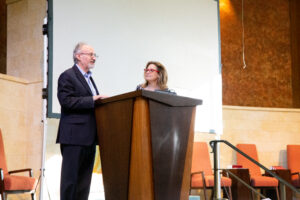By Lee Chottiner
Managing Editor
“We used to help refugees because they were Jewish. Now, we help them because we are Jewish.
– Mark Hatfield,
CEO of the Hebrew Immigrant Aid
Society (HIAS)

Laura Selzer-Duny takes questions from Jeff Jamner during the Yom Hashoah program about her film, “Nobody Wants Us.” (Community photo by Robyn Kaufman)
In other words, Jews know what it’s like to flee an enemy, having done it many times.
So, nearly eight decades after the end of World War II, Jews have a moral obligation to help those fleeing war and oppression today.
Both points were made at this year’s Yom Hashoah program on April 27 at Adath Jeshurun. The program paid tribute to 86 Belgian Jews aboard the Portuguese steamship Quanza who, in 1940, sought refuge in the United States despite the U.S. State Department’s efforts to block their entry.
The program also lauded Jews today for aiding those refugees and asylum-seekers fleeing strife in their own homelands.
“We are not the only ones who have been touched by the randomness of trauma and death,” said Rabbi Ben Freed, the opening speaker. “Our zikaron (memory) should serve as a reminder for us to recognize those who have similar marks, and to do everything we can to help them as they flee their own traumas.”
The program screened excerpts from the documentary, Nobody Wants Us, the story of the Quanza. Through the intervention of American Jews, First Lady Eleanor Roosevelt and a relatively unknown State Department official, the Quanza passengers were saved.
Their salvation didn’t begin in the states, though.
Filmmaker Laura Selzer-Duny, who created Nobody Wants Us, said the Jews aboard the ship fled Belgium after the Germans invaded on May 10,1940. Many reached Bordeaux, France, where a Portuguese diplomat, Aristides De Sousa Mendes, defied his country’s orders and issued visas to the Jews.
“This man was a true hero,” Selzer-Duny told the audience, “standing up and conforming to what God was telling him to do, what his heart told him to do, and not what the government was telling him to do.”
The ship left Lisbon on Aug. 9 with more than 300 passengers, arriving in New York 10 days later, where 196 passengers with valid visas went ashore. The remaining 121 aboard sailed to Vera Cruz, Mexico, where 35 more were let off. The rest – mostly Belgian Jews – were refused entry.
For a time, it seemed as though the Quanza would face the same fate as the S.S. St. Louis a year earlier, when 907 passengers were turned away from Havana and Florida, forcing the ship to return to Europe. The Quanza even docked at Norfolk, Viriginia, specifically to take on coal for the return voyage.
While there, though, local attorneys Jacob and Sally Morewitz succeeded in holding the ship in port by suing the cruise line for breach of contract. Meanwhile, national Jewish figures, including Rabbi Stephen Wise of the World Jewish Congress and Cecilia Razovsky of the National Council of Jewish Women, lobbied for the passengers’ release.
Their plight reached First Lady Eleanor Roosevelt, who persuaded her husband, President Franklin D. Roosevelt, to have the immigration status of the passengers reviewed.
A State Department official, Patrick Murphy Malin, was sent to Hampton Roads to investigate. After interviewing the passengers, Malin, defying the wishes of his superiors, finally allowed them to come ashore.
“They all disembarked literally at 11 o’clock at night,” Selzer-Duny said. “The National Council of Jewish Women and their families came with their cars and they pulled up to the port in Norfolk, Virginia. … It’s just a great story.”
Jeff Jamner, who organized this year’s program, noted the parallels between the Quanza passengers and the people fleeing Ukraine, Afghanistan and other war-torn lands today.
“This relates to our time,” Jamner said. “We’ve seen refugees in our own time desperate to escape. We’re seeing them every day on the news.”
Speaking of those, refugees, Sara Klein Wagner, president and CEO of the Jewish Community of Louisville, said local Jews have been reaching out to refugees for some time, actively settling families from Syria, Afghanistan and Eritrea.
“There’s a common denominator of activism of our Jewish community, whether it’s individuals or whether it’s organizations, that stepped up and said hineini – I’m here to help,” Wagner said. “That’s still happening today.”
The program also highlighted three Holocaust survivors – all Louisville residents – who died this past year: Elias Klein, a renowned research scientist whose team invented the artificial kidney membranes used in dialysis treatment; Gila Glattstein, an Israeli pioneer who cofounded her kibbutz and became a surgical technician; and Fred Gross, a journalist who spoke about his experiences to audiences in eight states and authored the memoir, One Step Ahead of Hitler: a Jewish Child’s Journey through France.
“These are giants,” said Rabbi Robert Slosberg, paying tribute to the three.
Rabbi Simcha Snaid, in a videotaped message, introduced this year’s candlelight ceremony. Eleven candles were lit by survivors and relatives of survivors, with narration done by students from St. Francis of Assisi School.
Cantor David Lipp performed music in memory of members of the community who perished in the Holocaust. He also chanted El Malei Rachamim.
Rabbi Beth Jacowitz Chottiner led an adaptation of the Mourner’s Kaddish, which pairs each line of the prayer with the name of a concentration or death camp, a ghetto, or the scene of a modern-day genocide.
In his closing remarks, Rabbi Joe Rooks Rapport reminded the gathering that the act of remembrance is “a challenge to our souls,” requiring action to remember lives lost and, through the actions of others, lives saved.”
He said it calls on the living not to stand silent in the face of evil.
“This program tonight is an act of remembrance,” he said.


